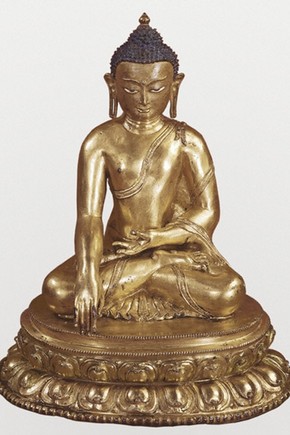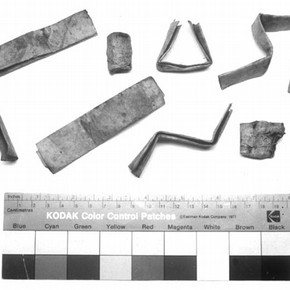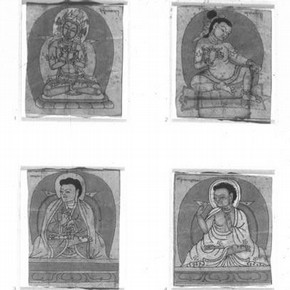Conservation Journal
Spring 2002 Issue 40
Ethical considerations in the treatment of a Tibetan sculpture

Figure 1. Sculpture of the Buddha Shakyamuni, Museum No. IM.121-1910 (click image for larger version)
A final year MA research project for the RCA/V&A Conservation programme conducted in 2001 focused on a 14th century Tibetan sculpture of the Buddha Shakyamuni (IM.121-1910). The sculpture was being sent on loan to the Millennium Galleries in Sheffield for the Precious exhibition. The loan assessment and consequent conservation treatment provided an opportunity for an in-depth study of the physical aspects of the sculpture. However, the additional issue of sacred items found inside the sculpture complicated matters. What began as an investigation of the technical features and deterioration factors of the sculpture, turned into an exploration of the ethical dilemma posed by intervention with a religious object. The following article will outline some of the main points of the enquiry.
The gilded and pigmented bronze sculpture was acquired during the 1904 British invasion of Tibet, known as the Younghusband expedition. It was purchased from a gallery in London by the Museum in 1910. Traditionally Tibetan Buddhist sculptures contain relics, which are blessed to fill them with sacred presence. From a religious viewpoint the contents should not be disturbed. However, at some time in the past, probably after the sculpture left Tibet, it was opened. 13 drawings and 6 rolled scrolls, which were removed from its centre, remain in the V&A’s collection but are stored separately from the sculpture.
During the conservation treatment in 2001 further items were detected inside the sculpture, through a gap in the base plate. The curatorial request for the removal of this material from inside the sculpture led to a lengthy deliberation over such an action. After careful consideration by senior conservation and curatorial staff, seven drawings, two wrapped objects and one scroll were removed from the sculpture. If the other objects had not already been removed from the sculpture, it would not have been reopened.
As the complexities of the case study unfolded it provided more examples of the questions that are introduced by such culturally significant objects housed within decorative arts museums. Ethical guidelines, particularly those of the V&A, the UKIC and ICOM were used to consider the action to be taken. They are outlined as follows: 1
The 1994 Victoria and Albert Museum Conservation Department Ethics Checklist
-
'Do I need to consult: clients, peers, other specialists?
-
Have I considered all the factors contributing to the identity and significance of the object: historical, technical, sacred, maker’s intention?
-
What effect will my actions have on the evidence of these factors?
-
Do I have sufficient information and skill to assess and implement action?'
The 1995 United Kingdom Institute of Conservation Rules of Practice
'1.1.7. Human remains and material of religious significance.
Each member must show respect for human remains and cultural property which have a ritual or religious significance. He/she should be cognisant of any special requirement, whether legal or social, of such material.'
'1.3.4 Alterations and removal of material
No aspect of cultural property should be altered nor should material be removed from it without justification.'
The 1986 International Council Of Museums Code of Professional Ethics
'6.7 Human remains and material of ritual significance
Where a museum maintains and/or is developing collections of human remains and sacred objects, these should be securely housed and carefully maintained as archival collections and in scholarly institutions, and should always be available to qualified researchers and educators, but not to the morbidly curious. Research on such objects and their housing and care must be accomplished in a manner acceptable not only to fellow professionals but also to those of various beliefs, including particular members of the community, ethnic or religious groups concerned. Although it is occasionally necessary to use human remains and other sensitive material in interpretative exhibits, this must be done with tact and with respect for the feelings for human dignity held by all peoples.'
The perspective offered by ethical guidelines for conservation is useful. However, the concepts referred to such as 'justification', 'cognition', 'tact and respect' are far from objective. The value of the material revealed by the investigation was a significant factor in the decision to remove the objects. Ultimately however, it was the viewpoint of the museum that carried the most weight since they are currently the owners of the sculpture.
In order to come to an understanding of the sculpture in its current context, four interviews were undertaken. Each of these related to a particular aspect of the sculpture:
John Guy and John Clarke, curators of the Indian and South East Asian Department of the V&A said that, at the V&A, the sculpture is presented as a religious object valued mainly for its high quality and large scale. Because of this, it is a central feature of the Himalayan collection. The historical associations that the sculpture has with the Younghusband expedition are also significant. (However, that subject provides more than enough material for a separate research project and was only considered here from a legal perspective, where it affected the ownership of this object.) 2
Anthony Burton, of the Research Department of the V&A and developer of the Precious exhibition in Sheffield was also interviewed. In Precious , the object was presented as an iconic image of the Buddhist religion. Its significance as an historic Tibetan object was not highlighted.
Jonathan Ashley-Smith, Head of Conservation at the V&A, suggested that the conservation of objects in the V&A do not usually focus on their religious requirements. However negotiation with members of originating communities does occur in the museum, as demonstrated recently for The Arts of the Sikh Kingdoms exhibition, where advice was given on how to display significant objects in a respectful manner.
Phuntsok Wangyal of the Tibet Foundation in London was also interviewed. He described how the sculpture would be regarded and displayed in a traditional context. As a Tibetan religious object, the sculpture is no longer being treated in this manner in the Museum. However, he also suggested that it may be a consolation for some people that the sculpture had been protected from the destruction of the Cultural Revolution by being taken out of Tibet.
The conflicts arising from different viewpoints of how to deal with culturally sensitive material are represented by this case study. Current museum perspectives on value and representation are demonstrated by the actions taken in these circumstances. The value of such objects is implicitly bound to their origins, and therefore this complexity must be considered when any treatment of the object, physical or otherwise, is undertaken. The process by which the subject is addressed reveals and reinforces certain attitudes towards the subject matter. The choices made for conservation action are embedded in this framework and are capable of reinforcing as well as challenging these preconceptions.
Additionally, the conservation of Tibetan objects is particularly complex as the originating community is currently being threatened in, or removed from, their homeland. The conservation of such objects could be seen as helping preserve the physical heritage of a people who are physically and socially or culturally threatened. This assumption, however, is problematic as it suggests that the material and social culture of such diasporic communities is not continually developing. This is of course not true. Therefore the challenges for museums that hold collections from living cultures are increasing.
The justification for the removal of the objects rested on what was revealed. They were in good condition and when the small paper objects were unfolded they showed figures drawn and coloured with well preserved pigment (figure 3). Each of the figures was labelled with Tibetan text indicating distinct individuals. They depict a lineage of Tibetan teachers associated with the Black Hat order. The drawings were dated stylistically to the 13th century. They are considered to have significant art historic merit because of their age and style but also provide information about the sculpture’s religious connections. The removal of the contents was therefore considered justified from the museum perspective.
In conclusion, this research began as an investigation into the conservation of a particular Tibetan sculpture, focusing on the physical aspects requiring attention. However, as the more complex meaning of the object was revealed, the research required expansion to include the spiritual nature of the sculpture and its contents. Ethical guidelines were used to consider the decision to remove the contents.
The initial removal of the internal objects is an unacceptable activity when considered in the framework of conservation ethics today. The decision to remove further objects in 2001 was only feasible because the sculpture has already been disturbed. By questioning our activities and by facing the realities of situations that have been inherited within museums, a more positive framework for future action by conservators working in this environment can be achieved.
A display of the sculpture and its newly discovered contents will be on display in on of the main entrance cases of the V&A from February 18th until 10 May 2002.
Acknowledgements
The author would like to thank the interviewees: Jonathan Ashley-Smith, Anthony Burton, John Clarke, John Guy and Phuntsok Wangyal and also the Paper Conservation Department of the V&A, particularly Shiho Sasaki for her assistance and advice.
References
1. Richmond, A., Conservation Ethics Workshop, V&A Conservation Journal, 10, pp 4-7 UKIC, Codes of Ethics and Guidelines for Advice, United Kingdom Institute for Conservation. 1995 ICOM, Codes of Professional Ethics, International Council of Museums, 15th General Assembly of ICOM, 1986, Argentina
2. The following conventions deal with this subject:
The Hague Convention, Convention for the Protection of Cultural Property in the Event of Armed Conflict, 1954.
The UNESCO Convention, UNESCO Convention on the means of prohibiting and preventing the illicit Import, Export and Transfer of Wnership of Cultural Property,1970.
The Unidroit Convention, Unidroit Convention on Stolen or Illegally Exported Cultural Objects, 1995.
Spring 2002 Issue 40
- Editorial
- Sustainability and precaution - Part 1
- People watching: Monitoring heritage hospitality functions in historic houses
- Ethical considerations in the treatment of a Tibetan sculpture
- Building models: Comparative swelling powers of organic solvents on oil paint and the cleaning of paintings
- Further applications of Raman microscopy in paper conservation
- Critical evaluation of laser cleaning of parchment documents
- Collaboration
- Printer friendly version

